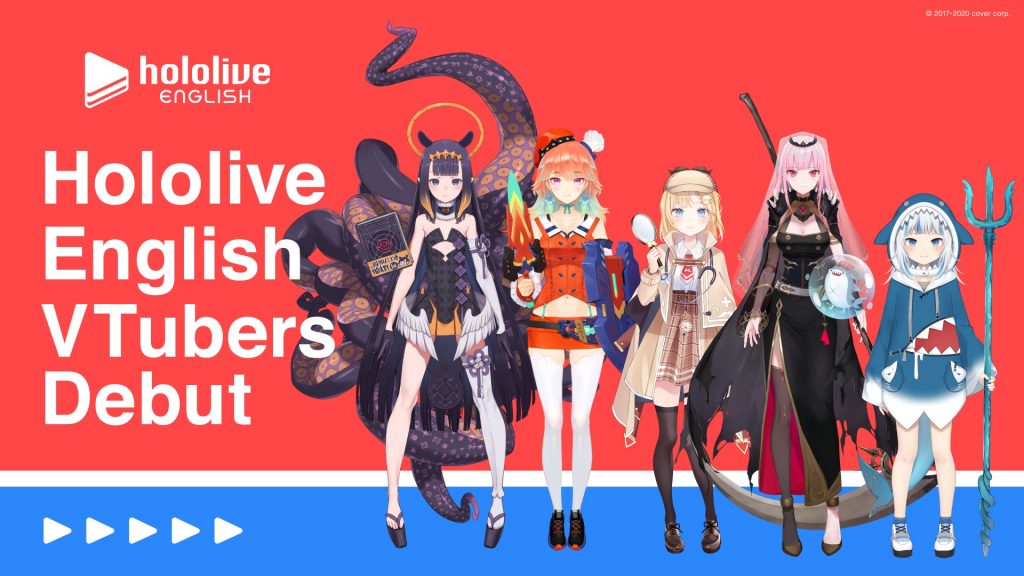Vtubers represent an interesting paradigm shift. To some extent, they can be seen as an extension of idol culture. But on another level, they’re something new entirely.
I talked before about how cute anime girl mascots help give brands identity and personality. Vtubers take that to another level. They bring the cute anime girl (or boy) to life, and become brands in and of themselves.
What Are Vtubers?

Put simply, a Vtuber is a video or streaming personality who uses a digital avatar to represent them onscreen. Face tracking and motion capture technology translates the actor’s movements to their avatar. This can take multiple forms and Vtubers exist at every level of sophistication.
Where it intersects idol culture is in the “on-stage” persona. The audience connects with the character, not the actor behind it. Vtubers are expected to keep up that dynamic. Their true identities are often closely-guarded secrets.
Similarly, the idol industry creates an elaborate kayfabe around its idols. Idols’ behaviour is often closely monitored, lest they do something to “break character” like date men.
Vtubers have more freedom. Their real selves aren’t in the public eye. They’re only known as a voice and an anime character.
Both, however, deal with the same concept: Creating human brands.
What Is A Human Brand?
Talent agencies exist to manage human brands. We think of talent agencies as working in Hollywood, or the idol industry, but they exist everywhere talent exists. There are talent agencies that manage Youtubers, Twitch streamers, and even Vtubers.
It’s a growing market, with multiple players on both the Japanese and US sides. Hololive Production is the most well-known of the Japanese companies. The company manages streamers like Usada Pekora, Inugami Korone, and Gawr Gura.
They follow the formula established by the idol industry. Their Vtubers “debut.” They operate solo and in groups. They’re closely managed. Retirement is called “graduation.” Breaking kayfabe is not tolerated.
Hololive provides marketing, management, and supplies equipment to stream. In exchange they take a percentage of their talent’s revenue (Usually Youtube Superchats). The real value proposition, however, is in the characters themselves.
How Do Vtubers Create Profit?

The characters, played by their actors, become brands. This is different from what Megumi Haruna does for J-List or what Mirai Suenaga does for Culture Japan. Gura doesn’t exist to market Hololive. Gura exists to be Gura. Hololive just makes money off of that.
The same is true for other Vtuber agencies. VShoujo with Projekt Melody, or Nijisanji with Suzuhara Lulu.
More traditional media companies have jumped on the wagon, too. Kadokawa put out a series of Youtube videos featuring an animated avatar of Uzaki-chan gaming. More recently, Overflow, the company behind the infamous School Days, debuted a Vtuber of series heroine Kotonoha to mixed results (They’ve since improved the avatar).
Who Can Benefit From Vtubers?
Having a character associated with your brand can be powerful marketing. Bringing that character to life, however, is a lot of hard work and a big investment. The payoff can be a windfall for your company, but won’t happen unless nurtured properly.
Retails stores and software companies certainly benefit from having mascot characters. A Vtuber, however, is a more natural step for companies that already produce media. Other companies can benefit from the Vtuber phenomenon by securing brand deals and collaborations.
Much like how Mr. Beast collaborated with a “cloud kitchen” company to create the Mr. Beast Burger, companies can collaborate with Vtubers and Vtuber agencies to create branded products and experiences. It’s a win-win.
The Vtuber revolution is clearly here to stay. It’s fun, creative, and will no doubt make a lot of people a lot of money over time.
